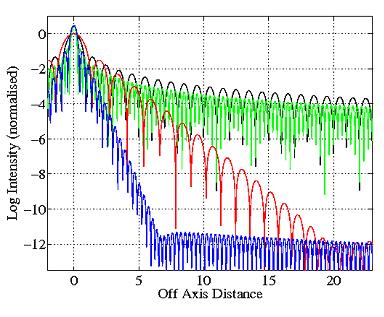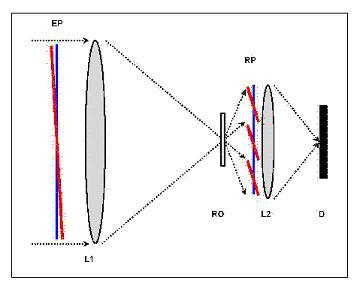Exo-planet imaging
When imaging a star through a telescope, a nearby planet will be much fainter than the star, and is therefore very hard to detect. At visible wavelengths an exo-planet image will be typically 10^-9 to 10^-10 times as bright as its host star and in the thermal infra-red the planet will be approximately 10^-6 times as bright as the star. This large dynamic range leads to requirements that can hardly be met by today's techniques.
The angular resolution required to image exo-planets can however be modest - at 20 parsec distance 1 AU is equivalent to 50 milli-arcseconds (mas). But a telescope giving this resolution will still produce diffraction rings in the star image whose peaks exceed the planet flux out to large angles from the star. This is shown in figure 1 where the black line gives the side-lobe brightness in a 1-dimensional system as a function of angle from an axial object in units of λ/D (wavelength / telescope-diameter).

Figure 1: Side-lobe brightness in a 1-dimensional system as a function of angle from an axial object
(in units of λ / telescope-diameter)
In figure 1 we see the normalised logarithmic image intensity for an axial source with various optical systems. The black curve is the intensity in an unapodised and un-replicated system and shows the image intensity as a function of angle from the source in units of λ / D at 1000 nm wavelength. The green line shows the image intensity for an unapodised system that includes 3-fold pupil replication. Note the narrower and brighter axial image and the reduced side-lobe levels. The red line shows the image intensity obtained from an un-replicated system with an amplitude-only super-Gaussian pupil apodisation and the blue line the same system but with 3-fold pupil replication and apodisation included. Both apodised systems, with or without pupil replication, have an optical efficiency of 65%.
In general, to achieve dynamic ranges better than 10^-6 the principal techniques utilise interferometric null steering. For all such systems vital performance parameters are the inner-working angle (IWA - the smallest planet-star angle beyond which an exo-planet may be detected) and the fraction of the azimuthal search space that may simultaneously be searched for an exo-planet. If the IWA is too large planets close to the star cannot be imaged. If the azimuthal search space is too small the efficiency of observation is reduced and the complexity of the search strategy is increased.
Current coronograph designs for space missions concentrate on image-plane masks of pure phase or pure amplitude type or on pupil apodisation. These approaches aim to facilitate the efficient removal of the star flux on an image plane mask and/or on a pupil-plane mask (e.g. a Lyot stop). One of the principal problems is that, to achieve adequate suppression of the star flux, the image-plane mask must extend to n*λ / D, where n is typically several times the width of the diffraction-limited star image width. This increases the IWA for a given telescope size, sometimes excluding the habitable zone from the searchable region.
It thus follows that a decrease in the angular diameter of the star image will improve the performance of an exo-planet imaging system. Such a decrease can be achieved by using a larger diameter telescope (with the added benefit of greater flux collection), but an alternative is to use pupil replication with a modest diameter telescope. To achieve the required improvement in exo-planet imaging, extra optics to effect the pupil replication is inserted into the telescope optical path before implementation of the pupil apodisation or coronograph.
Pupil replication is a new optical technique that decreases the diameter of the image of a star on the optical axis by replicating the input pupil of the telescope and reimaging this composed pupil onto the detector. This is shown in figure 2, and described below. Pupil replication is an auxiliary technique intended to improve the imaging spectroscopic performance of coronographic or pupil apodisation techniques.

Figure 2: A schematic of the optical system used to produce pupil replication
Figure 2 is a schematic overview of the principle of pupil replication. The wave front, after passing through the entrance pupil (EP), is focused by the optical system (L1) and then divided equally in amplitude 3 ways using the replication optics (RO). Thus 3 replicated images of the entrance pupil are formed side by side in the replication plane (RP), each 1/3 of the intensity of the original pupil image. If the source is an axial point (blue lines) the replicated wavefronts form a continuous plane wave front. If the source is off axis (red lines), the replicate wave fronts form a disjointed wave front. The resulting wave front is then passed through an imaging system (L2) and an image of the point object is formed through this lens on the detector (D). The optical system L2 is presumed to incorporate the coronograph or apodisation masks (not shown).
With pupil replication one can improve the suppression of starlight in high-dynamic range exo-planet imaging and image planets closer to their host star. We analysed the concept of pupil replication and used numerical simulations to show that it may be combined with pupil apodisation to improve exo-planet detection and spectroscopy (see our exoplanet imaging publications for more details). One of the results is shown in Figure 1, which indicates the gain in performance of a coronagraphic system that can be achieved when pupil replication is used.
The principle is applicable both to imaging through a single-aperture system and to imaging with an interferometer such as DARWIN or VLTI. The underlying principle of pupil replication is that one may violate the principles of homothetic mapping (a one-to-one relationship between input and exit pupil in imaging) whilst maintaining high-quality optical performance over an extremely small field of view. Beyond this narrow field of view the imaging performance will be anisoplanatic, but for the class of observation considered here the slightly-degraded image quality off-axis is an acceptable price to pay for the improved dynamic range. Using 'pupil replication' one may achieve compressed images of the host star whilst suffering only some chromatic defect in the (uncompressed) off-axis planetary images. The compressed images of the host star might, slightly misleadingly, be thought of as 'super-resolved'. This effect may be used to concentrate the host flux in order to improve the efficiency with which it can be removed from the image, leading to a significant improvement in dynamic range.
back to top
Resources
In this section you'll find background information for our research interests (past and present) and useful links to other sites.